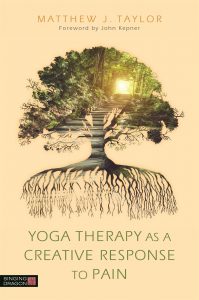 In this extract from Matthew J. Taylor’s latest book, Yoga Therapy as a Creative Response to Pain, Taylor discusses how yoga therapy can be used to decrease pain and the perception of pain.
In this extract from Matthew J. Taylor’s latest book, Yoga Therapy as a Creative Response to Pain, Taylor discusses how yoga therapy can be used to decrease pain and the perception of pain.
How does one teach from the wisdom of pain? And how could yoga therapy be a creative response? My hope is you are starting to see some answers emerge. (Pun intentional and literal.) In this section I will offer some direct implications to make some of this what they used to call “lieutenant-proof” in the army when I was a lieutenant. (Do note later, though, Nora’s caution around giving “direct” instructions.)
We “know,” taken together, the above findings are important because they demonstrate that the neural mechanisms involved in mindfulness- based pain relief are consistent with greater processing of sensory experience and at the same time decreases in pain appraisal (Zeidan et al. 2015). Our familiar practices of paying attention inward and editing narratives. Pain reduction may also occur by fine-tuning the amplification of nociceptive sensory events through top-down control processes of inhibition of incoming nociceptive information and that such pain relief does not reduce pain through one avenue, but rather multiple, unique neural mechanisms. Ah, CDSR. Zeidan and Vago (2016) also cite evidence that mindfulness meditation engages mechanisms that are distinct from placebo to reduce pain and that this could be of critical importance to the millions of chronic pain sufferers seeking a fast-acting non-opioid pain therapy. See the marketing section coming up next for how to use this information. There is a decoupling between “sensory and appraisal-related brain regions,” and similarly, between “sensory and affective pain” to increase coping with the pain that does improve. An alleviation of suffering even if pain is unchanged in intensity? This is the frequently reported decrease in the unpleasantness dimension of pain with respect to pain intensity (Zeidan et al. 2015) plus what we already discussed about yoga also altering the meaning, interpretation, and appraisal of nociceptive information, all of which could be important tools for producing more stable and long-lasting improvements in chronic pain symptoms. Wow! How do we do that?
Continue reading →
 “Fear invokes wars, elects tyrants to government offices, sell cosmetics and medications, belittles the human spirit, and tells us we are not enough”.
“Fear invokes wars, elects tyrants to government offices, sell cosmetics and medications, belittles the human spirit, and tells us we are not enough”.
 take for you to shift to “moving through” the holidays or “experiencing” the holidays rather than just trying to get through them? Although the difference in this wording is somewhat subtle, it can be significant as we shift from survival mode into a more holistic acceptance of the process of being present—mind, body, and soul—for the holidays.The glow of Christmas trees, menorahs, and Diwali candles, along with many other images and traditions from richly diverse cultures, light our way through the holidays each year. Along with the beauty of holiday decorations and celebrations, however, often comes a fair amount of stress. This could be financial stress or the stress of physical exhaustion from simply trying to keep up with all of the extra events. It could also be emotional stress due to an injury or illness, challenging family dynamics, or grief from the loss of a loved one. Pause for a moment and check in: On a scale of 1 to 10, what is your current stress level? Breathe. Look around you. Then, look within. Is there any crisis taking place in the current moment, or is the stress generating from within? Feel the soft rhythm of your inhale and exhale washing through you with grace.
take for you to shift to “moving through” the holidays or “experiencing” the holidays rather than just trying to get through them? Although the difference in this wording is somewhat subtle, it can be significant as we shift from survival mode into a more holistic acceptance of the process of being present—mind, body, and soul—for the holidays.The glow of Christmas trees, menorahs, and Diwali candles, along with many other images and traditions from richly diverse cultures, light our way through the holidays each year. Along with the beauty of holiday decorations and celebrations, however, often comes a fair amount of stress. This could be financial stress or the stress of physical exhaustion from simply trying to keep up with all of the extra events. It could also be emotional stress due to an injury or illness, challenging family dynamics, or grief from the loss of a loved one. Pause for a moment and check in: On a scale of 1 to 10, what is your current stress level? Breathe. Look around you. Then, look within. Is there any crisis taking place in the current moment, or is the stress generating from within? Feel the soft rhythm of your inhale and exhale washing through you with grace.